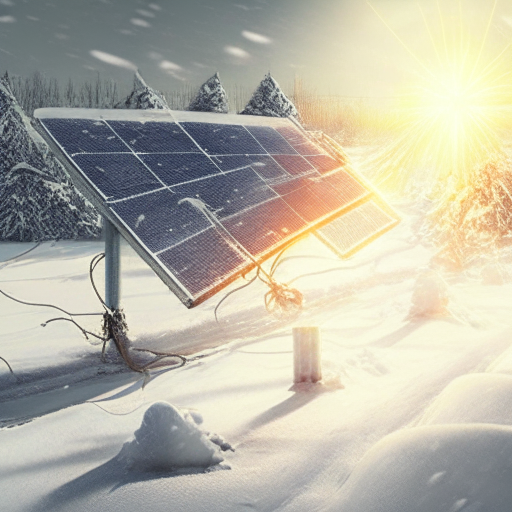Maximize Solar Energy Efficiency in Extreme Cold Weather: Proven Strategies for Survivalists
As a dedicated survivalist, you understand the critical importance of achieving self-sufficiency, especially when grappling with the challenges posed by harsh winter weather. One of the most pressing issues you may face is the effective utilization of renewable energy solutions, particularly solar power, in frigid temperatures. While the harsh chill may seem like a formidable obstacle, there’s no need for alarm! This article will uncover the untapped potential of harnessing solar energy in cold climates. We are set to share actionable strategies that will empower you to effectively capture solar energy, even amidst the most severe winter conditions, by embracing a proactive and informed approach.

Many people mistakenly believe that solar electricity can only be harvested in warm, sunny locales. However, thanks to remarkable advancements in technology, capturing solar energy in colder climates is not just feasible—it's entirely practical. Let’s explore the various innovative techniques that enable solar power systems to thrive in extreme cold, and how you can leverage this sustainable, eco-friendly energy source to significantly enhance your lifestyle and survival strategies effectively.
First and foremost, it’s crucial to understand that solar panels generate energy from sunlight rather than warmth. Although cooler temperatures can affect the efficiency of solar panels, they do not render them ineffective during winter months. By employing strategic planning and adopting innovative techniques, you can significantly boost the performance of your solar power system, ensuring it operates at peak efficiency even in the coldest environments. Gaining insight into the mechanics of solar panel functionality across varying temperatures will empower you to make informed decisions about effectively meeting your energy demands.
One essential factor in optimizing solar electricity in cold climates is the angle and orientation of your solar panels. Proper alignment can dramatically enhance the amount of sunlight your panels absorb throughout the day. During winter, the sun’s trajectory is lower in the sky, making it essential to tilt your panels at a steeper angle. This strategic adjustment allows for maximum sunlight capture, thereby improving their overall efficiency. Additionally, orienting the panels towards the south can further amplify their sunlight collection capabilities, which is particularly advantageous during the shorter winter days.
Snow accumulation poses another significant challenge in colder regions, potentially obstructing the effectiveness of your solar panels. A substantial layer of snow can drastically diminish electricity output. However, by confronting this issue proactively, you can implement effective solutions. Consider installing snow barriers or heating elements on your solar panels to prevent snow buildup. These enhancements not only facilitate the melting of existing snow but also ensure continuous energy production, even during snowstorms. Regularly clearing snow by hand can also serve as an effective maintenance strategy to keep your panels functioning optimally and free from obstructions.
Integrating battery storage systems represents a forward-thinking approach to enhancing solar power efficiency in cold conditions. These batteries allow you to store excess energy generated during daylight hours for use when sunlight is limited or temperatures drop. The importance of battery storage becomes especially pronounced in freezing conditions, as it guarantees a reliable supply of electricity when you need it most. By investing in a robust battery system, you can maintain your energy independence and be well-prepared for any unforeseen circumstances that may arise during severe weather.
Choosing the right type of solar panels is critical for optimizing your solar energy system’s efficiency in cold climates. Certain panels are specifically engineered to perform better at lower temperatures and may feature enhanced insulation or specialized materials designed to minimize the impact of frost and ice on their performance. By making an informed choice about the panel types that best suit your cold environment, you can maximize energy production and ensure that your solar power system consistently meets your energy needs effectively.
Beyond technical considerations, having your solar power system installed by professionals experienced in cold climate conditions is essential. Skilled installers can provide best practices for installation, ongoing maintenance, and troubleshooting, offering invaluable insights into optimizing your system. Their expertise will help ensure that your solar setup operates at peak efficiency, even under the most challenging winter conditions, ultimately enhancing the reliability of your energy source. This professional guidance can be a game-changer in ensuring your system's longevity and performance.
Maintaining a proactive and prepared mindset is crucial in survival scenarios. While solar power can serve as a dependable and effective energy source in cold climates, having backup generators or alternative energy solutions is vital. These additional measures will act as a safety net in case of extended periods of low sunlight or unexpected system failures. By integrating solar power with other renewable energy sources, you can further enhance your energy independence and resilience, ensuring that you are well-equipped to tackle any weather-related challenges that may arise.
Solar energy is not limited to warm and sunny areas; it holds immense potential even in the coldest climates, provided it is strategically planned and technically advanced. By adjusting your panel angles, addressing snow accumulation challenges, incorporating battery storage, selecting suitable solar panels, relying on skilled installation, and having contingency plans in place, you can unlock the complete potential of solar energy in extreme cold. Embrace renewable energy with confidence and resourcefulness, ensuring your survival and sustainability in any climate.
The post Solar Energy in Extreme Cold: Unlocking Its Full Potential appeared first on Survival Bite.
The Article Solar Energy’s Full Potential in Extreme Cold Conditions Was Found On https://limitsofstrategy.com


Your insights on maximizing solar energy efficiency in extreme cold resonate deeply with my own experiences as a survivalist. It’s fascinating to think about how many of us still hold onto the misconception that solar power is strictly for sunny regions. I’ve been experimenting with solar panels during the winter months, and I’ve found that even on overcast days, they can still deliver surprising results.
Ah, the chilly embrace of winter and the endless quest for solar power! It reminds me of my overly ambitious attempt to charge my solar-powered garden lights during a snowstorm last year—let’s just say they ended up more decorative than functional. It’s fascinating how our perceptions of solar energy are so often clouded (pun intended) by misconceptions. I recently read that solar panels actually perform better in colder temperatures, provided there’s enough sunlight. It’s kind of like us humans preferring to exercise outside in winter; the air might be frosty, but we’re still burning those calories!
This is such an important topic for those of us living in colder regions. I’ve always found that people underestimate the potential of solar power in winter. For instance, I’ve been experimenting with solar panels mounted on rooftops that are designed to tilt toward the sun—it’s surprising how even a few hours of weak sunlight can make a difference.
You make a great point about the potential of solar power in winter—it’s something that often flies under the radar. I’ve also been exploring how angle and positioning can really maximize exposure, especially in our region where the sun’s path changes so drastically with the seasons. It’s interesting how what might seem like weak sunlight can still be so beneficial.
Your exploration of solar energy’s potential in extreme cold is not only timely but essential for those of us aiming for self-sufficiency. It often surprises people to realize that solar efficiency isn’t solely tied to high temperatures. In my experience as a winter enthusiast and survivalist, I’ve found that understanding the unique ways solar technology operates in colder climates can truly shift our perceptions and practices.
You’ve raised an excellent point about the surprising dynamics of solar efficiency in colder climates. It’s fascinating how much we often associate solar power with heat and sunshine, yet the technology itself can still perform well in unexpected conditions. As a winter enthusiast, it must be interesting to witness the ways solar panels can adapt to the challenges of snow and lower light levels.
I completely agree with your perspective on the relationship between solar power and colder climates. It’s intriguing how solar technology defies our typical expectations. While we often think of solar panels as being most effective under constant sunlight, they do indeed have a unique ability to perform well even in lower light conditions. I’ve noticed, for instance, that the snow can actually provide a surprising benefit; a fresh layer can reflect sunlight and help the panels generate more energy as it melts.
Your insights on maximizing solar energy efficiency in extreme cold weather strike a chord, especially for those of us deeply invested in self-sufficiency and preparedness. It’s intriguing how many people overlook the capabilities of solar panels in cold climates, often equating efficiency solely with warmth and sunlight.
It’s great to hear that the topic resonates with you. Many people don’t realize that solar panels often perform better in colder temperatures, not to mention the snow reflects light and can actually boost energy production. It’s all about mindset—people often associate solar energy with warmth, but in reality, these systems can thrive in various conditions.
I couldn’t agree more with your point about the often-overlooked efficiency of solar panels in cold weather. A lot of folks don’t realize that solar panels actually work well in cooler temperatures, sometimes better than in scorching heat. The efficiency of solar cells can actually improve as temperatures drop, since heat can reduce their effectiveness.
I’m glad to hear that my insights resonate with you! If you’re interested in exploring more ways to enhance solar energy efficiency, check out this resource—it offers valuable tips tailored for cold climates.
https://arquiaca.org/eComToolkit
I couldn’t help but chuckle at the notion of solar panels huddling together, trying to stay warm through those arctic winds! It’s a common misconception that solar energy takes a backseat in cold weather, but as you’ve rightly pointed out, those frosty temperatures don’t dim the sun’s rays. In fact, I’ve found that some of the most efficient solar energy systems I’ve come across are in places like Alaska – those folks know a thing or two about harnessing that chilly sunshine!
It’s funny to think about those solar panels trying to huddle together. You’re right, though—many people don’t realize how well they perform in colder climates. Those Alaskan systems really shine in the winter, largely due to the clear skies often present during that time.
You’re spot on! It’s funny to picture those solar panels trying to cozy up against the wind, right? But you’re right about how they can thrive in the cold. It’s all about that sunlight, and places like Alaska show how resourceful people can be with solar. The lower maintenance and durability of solar in harsh climates can really surprise folks. Plus, the long summer days up there can really crank up energy production. It’s a neat reminder that we can rethink how and where we use solar power—just depends on the creativity and innovation of those utilizing it! Have you had any experiences with solar in cold regions? Would love to hear about it!
Absolutely! If you’re curious about how solar energy thrives even in colder climates, check out this informative resource that highlights the benefits and technology behind efficient solar systems in chilly regions.
https://arquiaca.org/SmoothieRecipes